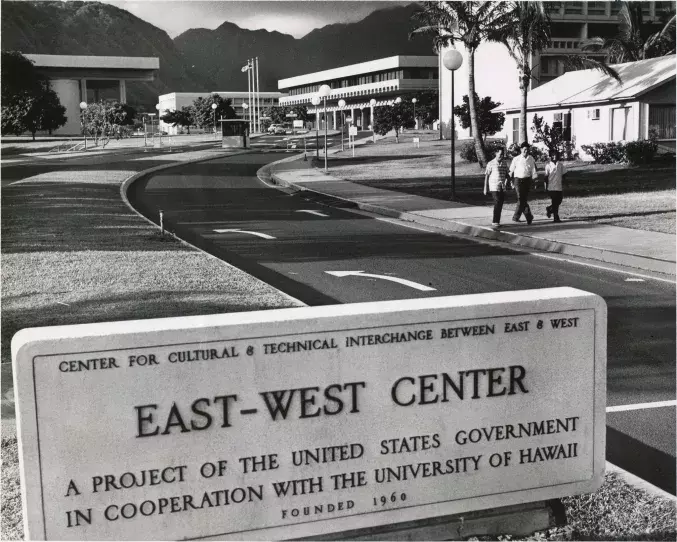
The East-West Center was established by the United States Congress in 1960 as a national educational institution to foster better relations and understanding among the peoples of the United States, Asia, and the Pacific islands through programs of cooperative study, training, and research.
The Center was established in Hawaiʻi based on the conclusions reached by Congress and the US Department of State that Hawaiʻi offered special advantages for a national institution with an Asia Pacific focus that could not be duplicated anywhere else in the country. In early 1959, as Hawaiʻi’s statehood was approaching, John A. Burns, Hawaiʻi’s Territorial Delegate to Congress, and the then- Senate Majority Leader Lyndon Johnson, both agreed that the East-West Center was an idea whose time had come. Senator Johnson first publicly suggested the concept of an international center during a speech at the American Society of Newspaper Editors in Washington, DC on April 16, 1959. He proposed that the nation establish an international university in Hawaiʻi “as a meeting place for intellectuals of the East and West.” In order to implement this concept, on June 9, 1959 Senator Johnson introduced a bill in the Senate to establish “a Center for Cultural and Technical Interchange Between East and West in Hawaii.” An identical bill was introduced into the House of Representatives on behalf of John Burns. Congress then passed P.L. 86-108 on July 24, 1959, which included an amendment calling for the Secretary of State to prepare a plan for the establishment of the Center.
“At the Center itself, people will engage actively in what is perhaps the most precious freedom of all— the freedom to pursue ideas. . . One real strength of the Center is that it is not a one-sided institute of propaganda. People will meet there on humanly equal terms and will engage in genuine dialogue from which each will learn and to which each will contribute.”
John Burns, appealing to a Senate Subcommittee
In August, the Department of State assembled an inter-agency working group to formulate the details of creating such an institution. The working group visited Hawaiʻi and reviewed proposals drafted by a committee of University of Hawaiʻi representatives and state officials. The State Department report submitted to Congress in December 1959 concluded that “an international center, as proposed, concentrating on Asian and Pacific affairs and established in connection with the University of Hawaiʻi, would make a valuable contribution to the programs of the United States for the promotion of international educational, cultural, and related activities.” On April 19, 1960 Hawaiʻi Senator Oren Long introduced a bill for the establishment of the East-West Center, which was signed into law by President Eisenhower on May 14, 1960 (Public Law 86-472, Chapter VII). An initial $10 million dollar Congressional appropriation supported the creation of the Center and in September of that year, the East-West Center’s first student, Abdul Q. Zia, arrived from Pakistan.
Learn more about the East-West Center's history:
The East-West Center was established by the United States Congress in 1960 as a national educational institution to foster better relations and understanding among the peoples of the United States, Asia, and the Pacific islands through programs of cooperative study, training, and research.
The Center was established in Hawaiʻi based on the conclusions reached by Congress and the US Department of State that Hawaiʻi offered special advantages for a national institution with an Asia Pacific focus that could not be duplicated anywhere else in the country. In early 1959, as Hawaiʻi’s statehood was approaching, John A. Burns, Hawaiʻi’s Territorial Delegate to Congress, and the then- Senate Majority Leader Lyndon Johnson, both agreed that the East-West Center was an idea whose time had come. Senator Johnson first publicly suggested the concept of an international center during a speech at the American Society of Newspaper Editors in Washington, DC on April 16, 1959. He proposed that the nation establish an international university in Hawaiʻi “as a meeting place for intellectuals of the East and West.” In order to implement this concept, on June 9, 1959 Senator Johnson introduced a bill in the Senate to establish “a Center for Cultural and Technical Interchange Between East and West in Hawaii.” An identical bill was introduced into the House of Representatives on behalf of John Burns. Congress then passed P.L. 86-108 on July 24, 1959, which included an amendment calling for the Secretary of State to prepare a plan for the establishment of the Center.
“At the Center itself, people will engage actively in what is perhaps the most precious freedom of all— the freedom to pursue ideas. . . One real strength of the Center is that it is not a one-sided institute of propaganda. People will meet there on humanly equal terms and will engage in genuine dialogue from which each will learn and to which each will contribute.”
John Burns, appealing to a Senate Subcommittee
In August, the Department of State assembled an inter-agency working group to formulate the details of creating such an institution. The working group visited Hawaiʻi and reviewed proposals drafted by a committee of University of Hawaiʻi representatives and state officials. The State Department report submitted to Congress in December 1959 concluded that “an international center, as proposed, concentrating on Asian and Pacific affairs and established in connection with the University of Hawaiʻi, would make a valuable contribution to the programs of the United States for the promotion of international educational, cultural, and related activities.” On April 19, 1960 Hawaiʻi Senator Oren Long introduced a bill for the establishment of the East-West Center, which was signed into law by President Eisenhower on May 14, 1960 (Public Law 86-472, Chapter VII). An initial $10 million dollar Congressional appropriation supported the creation of the Center and in September of that year, the East-West Center’s first student, Abdul Q. Zia, arrived from Pakistan.
Learn more about the East-West Center's history:

